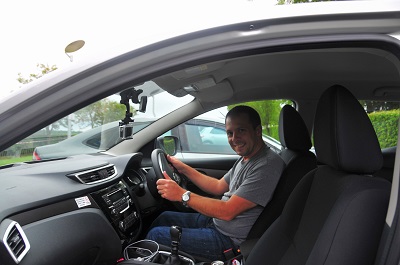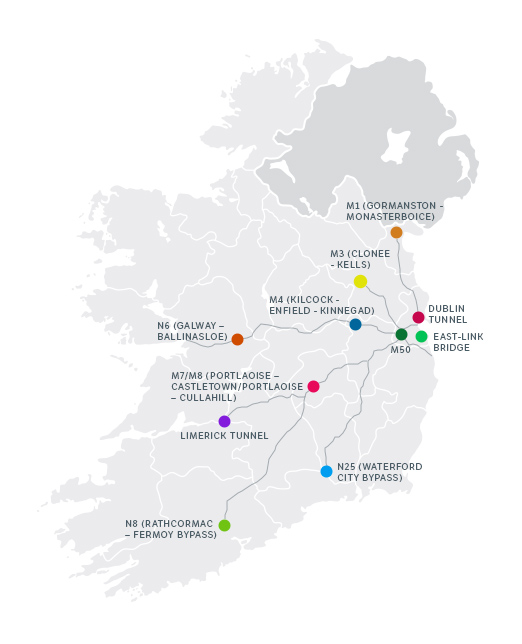 Much like England and the UK, they drive on the left in Ireland with the driver seated on the right side of the vehicle. This was my first attempt at this, but it wasn’t as bad as I feared it might be, and if you’re planning on driving in Ireland, or the UK and are nervous about this, hopefully this article may help to subside some of that fear.
Much like England and the UK, they drive on the left in Ireland with the driver seated on the right side of the vehicle. This was my first attempt at this, but it wasn’t as bad as I feared it might be, and if you’re planning on driving in Ireland, or the UK and are nervous about this, hopefully this article may help to subside some of that fear.
Reminders to stay on the left
Our rental company displayed a huge sign in the windshield to remind drivers to STAY ON THE LEFT, however this wasn’t as hard to remember as you may imagine, especially in crowded cities and towns (because everyone else on the left is a clear reminder of where to be). I found that with the driver’s seat being situated on the right side of the vehicle (which was strange in itself), this was an immediate reminder every time I sat down that this would be a different driving experience – and thus, the reminder to stay on the left came to mind.
When first getting used to the experience I would audibly say “left, left, left” when pulling out of a parking lot or something just as a verbal queue to remember to do so, however it wasn’t long before I didn’t need this reminder at all. (You get used to it fairly easily).
What was more confusing to me was the fact that most Irish roads with lane markers seemed to have the opposite colors than those in the US. This to me is something worth mentioning. For instance, yellow lines in Ireland mark the outside of the road, while white lines mark lane dividers as well as the center divider. What makes this confusing is that on 2 lane roads, it wasn’t immediately distinguishable if the road featured 2 lanes in one direction or 1 lane each in opposite direction. Needless to say we managed without incident, however I feel it’s something travelers should be aware of to avoid driving accidentally into oncoming traffic!
Vehicle set up
Another thing to note for those curious (as I was) is the how the pedals and driving controls are laid out compared to American cars. The pedals (clutch, brake, and gas) are in the same order as they appear in US vehicles (left to right respectively). I feared if this was backwards, I may TRULY have a problem, but fortunately the engineers who designed these vehicles decided to save us at least a few headaches!
Most all vehicles in Ireland (and most other European countries) are manual transmission. You may be able to rent an automatic for additional cost, but you’ll find most companies will rent manuals only. With this said, the gear selector is also in the same order as it is in US vehicles (with 1st gear being on the left, and 6th being on the right). Basically the only thing different was the fact that the driver sits on the right instead of the left. They basically moved the steering wheel over, and left everything else the same. This was a little disorienting at first, especially having to up-shift towards me rather than away from me, and look to my left for the rear-view mirror rather than the right, but I quickly got the hang of it.
Tolls
There are 11 toll roads in Ireland. All of these tolls function like US tolls and have a manned booth to pay with cash except for one – the M50 toll in Dublin. This one is the tricky one you should be aware of if you’re planning on driving in and around Dublin. You can read all about it in my article here.

Narrow roads
As I mentioned earlier, many of the roads in Ireland are narrow. While there are a few select multi-lane highways similar to the US, most of the country is what we would think of as back-road driving. This consists of mostly 2 lane roads and highways, however there are plenty of 1 lane narrow roads with 2-way traffic to be aware of. In some cases, the road is just about as wide as the vehicle itself!
If you approach an on-coming vehicle (and you will) on one of these narrow roads, you may be expected to back up a bit to an opening along the way to pull over to let the other car pass. Sometimes the opposing vehicle will do this and let you pass but sometimes they may not be able to. It is therefore helpful to be mindful of openings along the roads as you pass them in case you need to pause and back up.
Livestock
As most are probably aware, Ireland is loaded with sheep. There are sheep everywhere. And while most people might expect to head down a wee Irish road and expect to find it blocked by a herd of sheep, or cows and have to sit and wait for them to move (as depicted in the movie “Leap Year”), this isn’t exactly normal. In fact, while you may come across a farmer moving his herd from a field on one side of the road to another and be forced to stop and wait (as we have), you should never find loose and wondering sheep or livestock on Irish roads. This is actually a pretty big offense in Ireland known as animal abandonment.
If you do manage to run into a stray or wondering animal such as a sheep, cow, or pig; here are the steps you should take according to Irish law:
- Do something – don’t just take pictures and keep on driving.
- Report the sighting to the Gardaí (Irish police) or better yet – take action yourself (more on this below).
- Impound the animal (keep the animal in your possession until authorities arrive)
If you are interesting in learning more about Irish law concerning the safety and well-being of stray and wondering livestock, you can read the law for yourself here. It is quite clear and explains how to handle a situation with stray animals on Irish roads.
I hope you found this article helpful. If you have any further questions about driving in Ireland or the UK or any foreign country, large city, or the like, please feel free to ask me and I will do my best to answer.







This Post Has 0 Comments